Chang-You Tai
Roll Up Your Sleeves: Working with a Collaborative and Engaging Task-Oriented Dialogue System
Jul 29, 2023Abstract:We introduce TacoBot, a user-centered task-oriented digital assistant designed to guide users through complex real-world tasks with multiple steps. Covering a wide range of cooking and how-to tasks, we aim to deliver a collaborative and engaging dialogue experience. Equipped with language understanding, dialogue management, and response generation components supported by a robust search engine, TacoBot ensures efficient task assistance. To enhance the dialogue experience, we explore a series of data augmentation strategies using LLMs to train advanced neural models continuously. TacoBot builds upon our successful participation in the inaugural Alexa Prize TaskBot Challenge, where our team secured third place among ten competing teams. We offer TacoBot as an open-source framework that serves as a practical example for deploying task-oriented dialogue systems.
Exploring Chain-of-Thought Style Prompting for Text-to-SQL
May 23, 2023Abstract:Conventional supervised approaches for text-to-SQL parsing often require large amounts of annotated data, which is costly to obtain in practice. Recently, in-context learning with large language models (LLMs) has caught increasing attention due to its superior few-shot performance in a wide range of tasks. However, most attempts to use in-context learning for text-to-SQL parsing still lag behind supervised methods. We hypothesize that the under-performance is because text-to-SQL parsing requires complex, multi-step reasoning. In this paper, we systematically study how to enhance the reasoning ability of LLMs for text-to-SQL parsing through chain-of-thought (CoT) style promptings including CoT prompting and Least-to-Most prompting. Our experiments demonstrate that iterative prompting as in Least-to-Most prompting may be unnecessary for text-to-SQL parsing and directly applying existing CoT style prompting methods leads to error propagation issues. By improving multi-step reasoning while avoiding much detailed information in the reasoning steps which may lead to error propagation, our new method outperforms existing ones by 2.4 point absolute gains on the Spider development set.
Hyperbolic Disentangled Representation for Fine-Grained Aspect Extraction
Dec 16, 2021
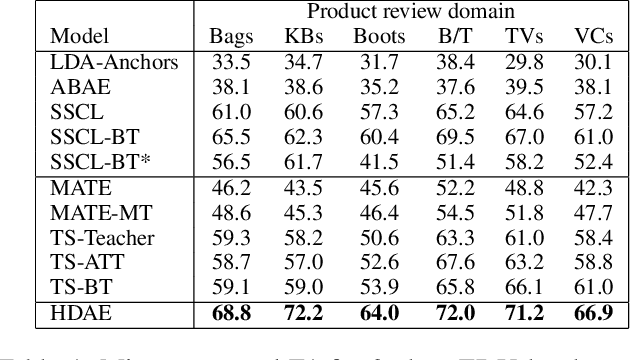
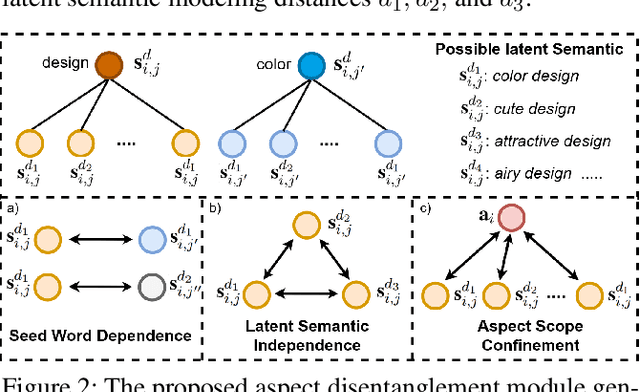
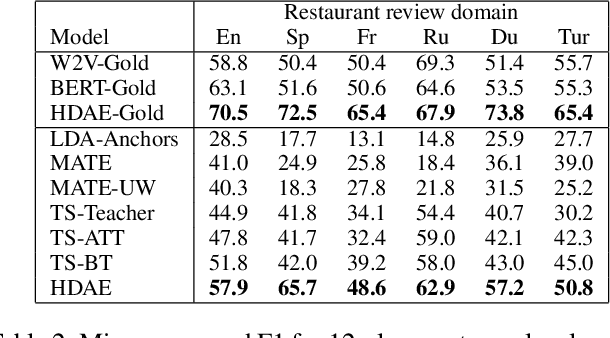
Abstract:Automatic identification of salient aspects from user reviews is especially useful for opinion analysis. There has been significant progress in utilizing weakly supervised approaches, which require only a small set of seed words for training aspect classifiers. However, there is always room for improvement. First, no weakly supervised approaches fully utilize latent hierarchies between words. Second, each seed words representation should have different latent semantics and be distinct when it represents a different aspect. In this paper, we propose HDAE, a hyperbolic disentangled aspect extractor in which a hyperbolic aspect classifier captures words latent hierarchies, and aspect-disentangled representation models the distinct latent semantics of each seed word. Compared to previous baselines, HDAE achieves average F1 performance gains of 18.2% and 24.1% on Amazon product review and restaurant review datasets, respectively. In addition, the em-bedding visualization experience demonstrates that HDAE is a more effective approach to leveraging seed words. An ablation study and a case study further attest to the effectiveness of the proposed components
MVIN: Learning Multiview Items for Recommendation
May 26, 2020
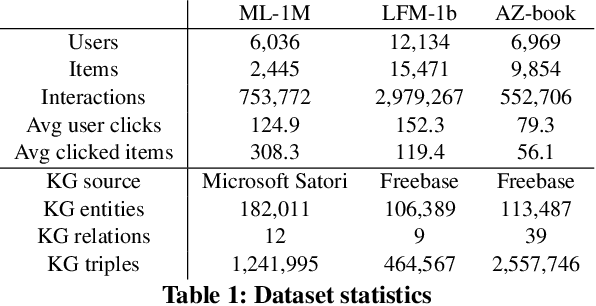
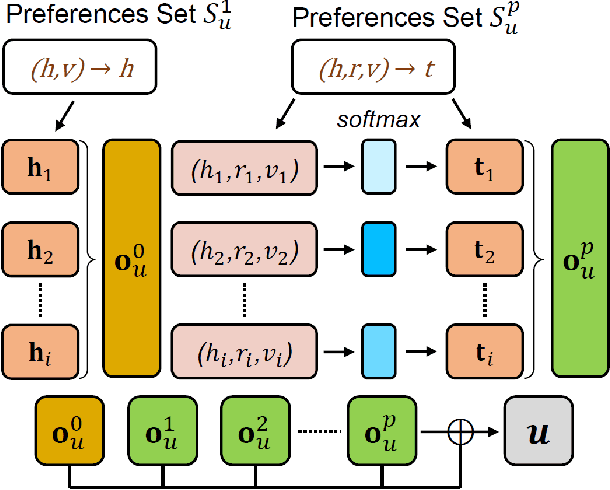
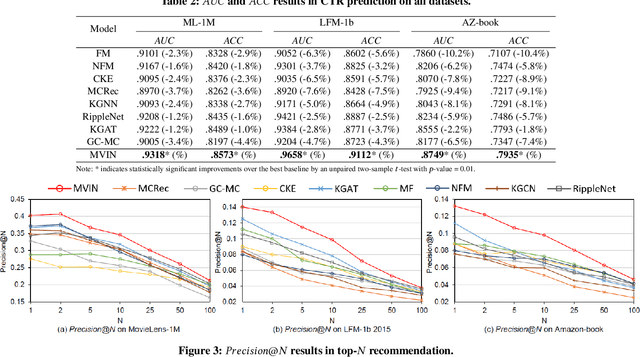
Abstract:Researchers have begun to utilize heterogeneous knowledge graphs (KGs) as auxiliary information in recommendation systems to mitigate the cold start and sparsity issues. However, utilizing a graph neural network (GNN) to capture information in KG and further apply in RS is still problematic as it is unable to see each item's properties from multiple perspectives. To address these issues, we propose the multi-view item network (MVIN), a GNN-based recommendation model which provides superior recommendations by describing items from a unique mixed view from user and entity angles. MVIN learns item representations from both the user view and the entity view. From the user view, user-oriented modules score and aggregate features to make recommendations from a personalized perspective constructed according to KG entities which incorporates user click information. From the entity view, the mixing layer contrasts layer-wise GCN information to further obtain comprehensive features from internal entity-entity interactions in the KG. We evaluate MVIN on three real-world datasets: MovieLens-1M (ML-1M), LFM-1b 2015 (LFM-1b), and Amazon-Book (AZ-book). Results show that MVIN significantly outperforms state-of-the-art methods on these three datasets. In addition, from user-view cases, we find that MVIN indeed captures entities that attract users. Figures further illustrate that mixing layers in a heterogeneous KG plays a vital role in neighborhood information aggregation.
GraphSW: a training protocol based on stage-wise training for GNN-based Recommender Model
Aug 19, 2019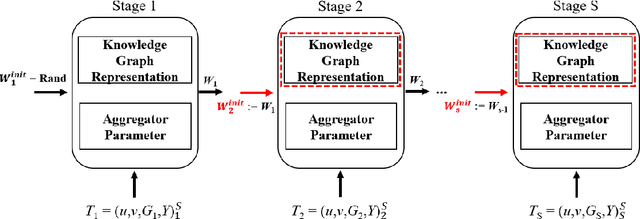



Abstract:Recently, researchers utilize Knowledge Graph (KG) as side information in recommendation system to address cold start and sparsity issue and improve the recommendation performance. Existing KG-aware recommendation model use the feature of neighboring entities and structural information to update the embedding of currently located entity. Although the fruitful information is beneficial to the following task, the cost of exploring the entire graph is massive and impractical. In order to reduce the computational cost and maintain the pattern of extracting features, KG-aware recommendation model usually utilize fixed-size and random set of neighbors rather than complete information in KG. Nonetheless, there are two critical issues in these approaches: First of all, fixed-size and randomly selected neighbors restrict the view of graph. In addition, as the order of graph feature increases, the growth of parameter dimensionality of the model may lead the training process hard to converge. To solve the aforementioned limitations, we propose GraphSW, a strategy based on stage-wise training framework which would only access to a subset of the entities in KG in every stage. During the following stages, the learned embedding from previous stages is provided to the network in the next stage and the model can learn the information gradually from the KG. We apply stage-wise training on two SOTA recommendation models, RippleNet and Knowledge Graph Convolutional Networks (KGCN). Moreover, we evaluate the performance on six real world datasets, Last.FM 2011, Book-Crossing,movie, LFM-1b 2015, Amazon-book and Yelp 2018. The result of our experiments shows that proposed strategy can help both models to collect more information from the KG and improve the performance. Furthermore, it is observed that GraphSW can assist KGCN to converge effectively in high-order graph feature.
 Add to Chrome
Add to Chrome Add to Firefox
Add to Firefox Add to Edge
Add to Edge